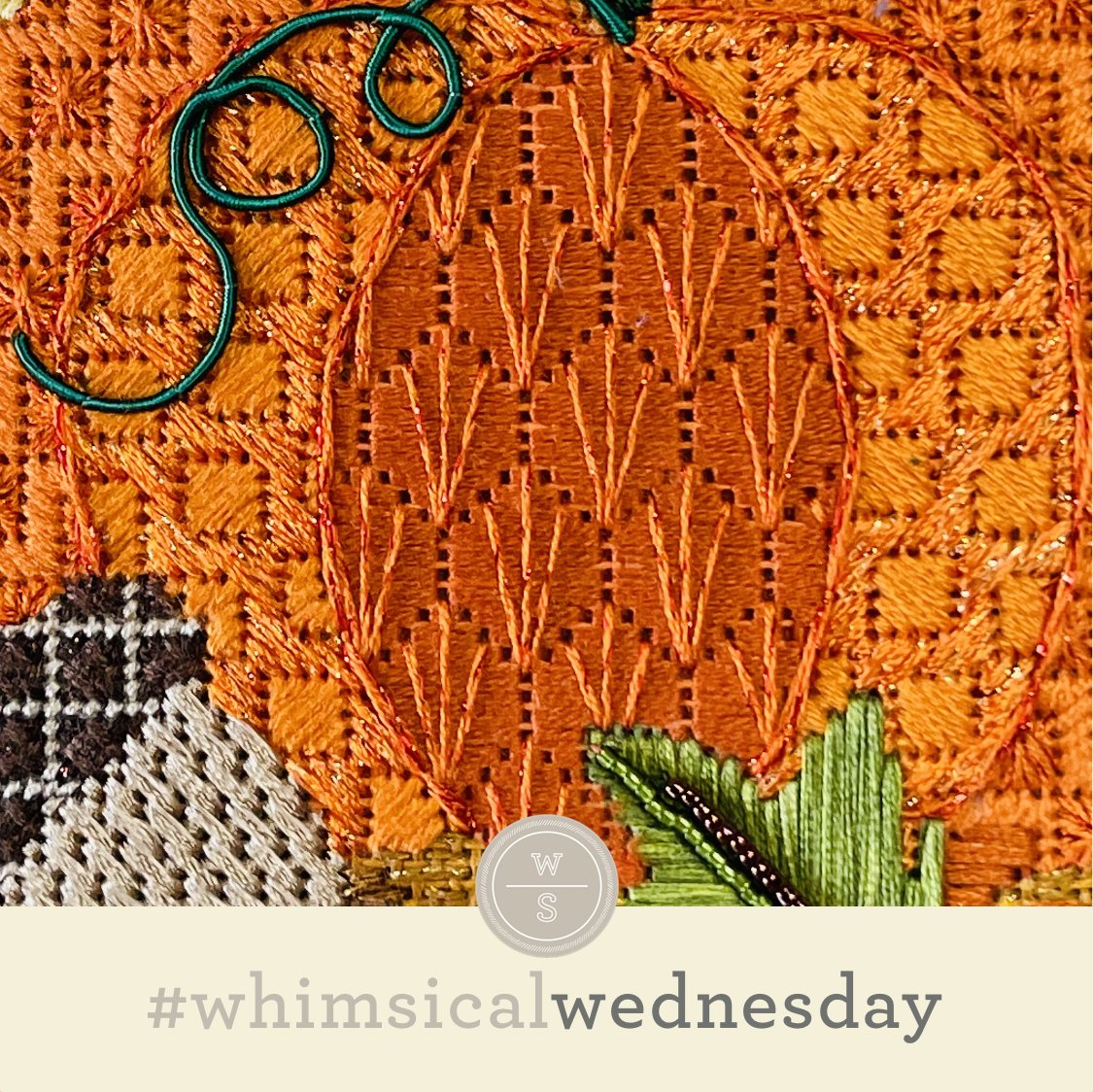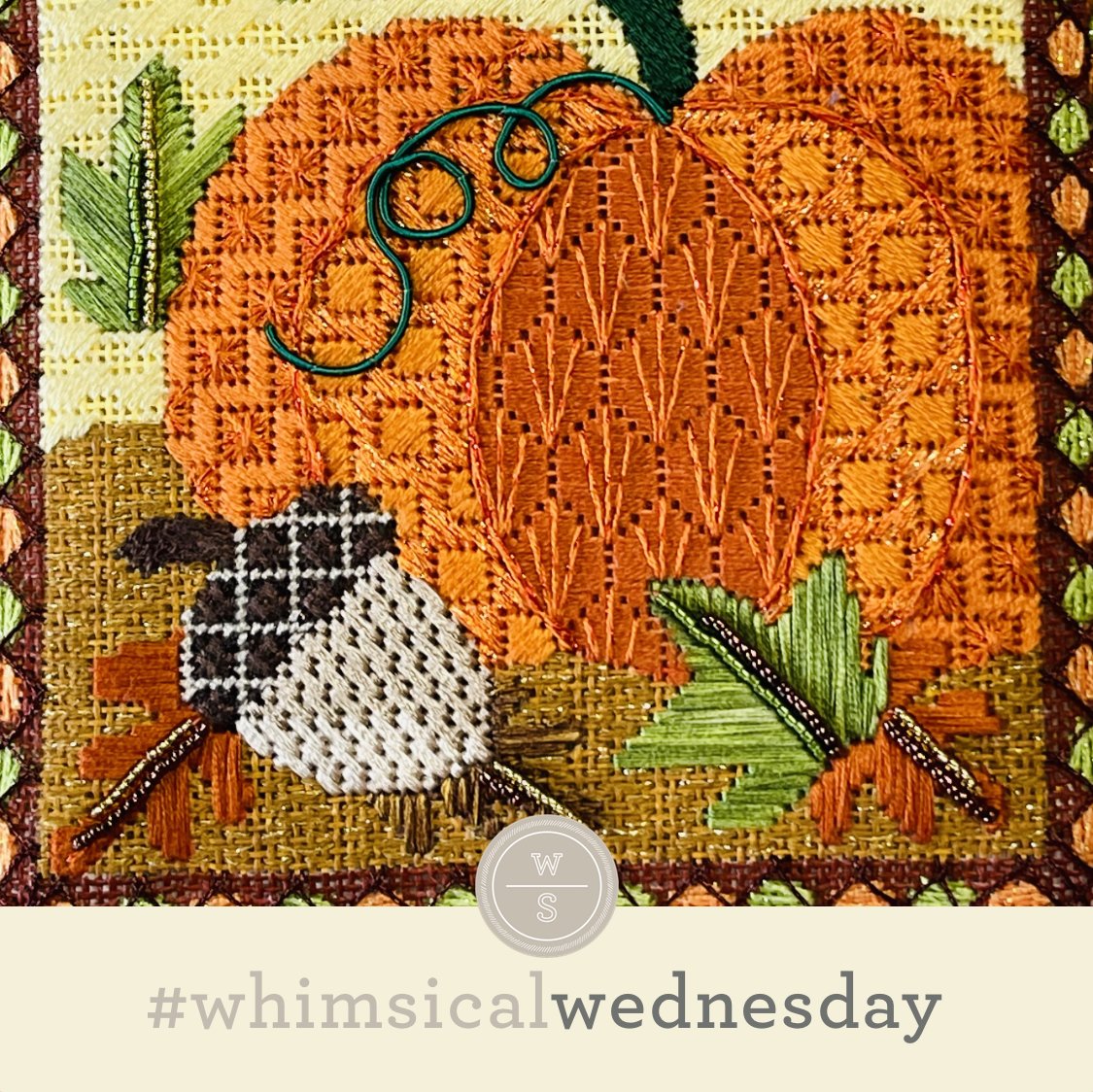It’s hot and I think we need a blast of Fall. And what is more Fall than Halloween? (Okay, maybe fall foliage but that isn’t exactly common in southern California.) Today’s blast of fall…I mean stitch…comes from my recent visit to Emily’s Stitchery in Northbrook, Illinois. It’s a dramatic stitch I’ve wanted to share with you for a while, and I love what Emily did with it!
There’s a lot to unpack here. The top left photo is the stitch diagram for the lighter orange panels on the pumpkin in the photo on the top right (from Emily’s Seasons Club). Other ideas to fill the 5X5 space occupied by the yellow lines are on the right-hand side of the diagram. The diagram on the second row is simply today’s stitch diagram without the stitched squares. I think that stitch is just as interesting, albeit for different spaces. The bottom right is a picture of the entire pumpkin for context.
The filled version of Diagonal Milanese Squares plays well with the other full coverage stitches in the pumpkin. I like how the square is stitched in the opposite direction to add some contrast. I am looking forward to using this stitch for a sweater with a Vineyard Silk (black lines) and a Silk Lame 18 (yellow lines). It also makes for an interesting roof with Rainbow Linen (black lines) and Elegance (yellow lines).
The empty version will make a fantastic snow stitch, especially if you need to add the overt direction cues, say if the snow is going up a hill. My favorite threads for snow are Petite Silk Lame, a size 8 Kreinik, or Flair as all of those threads help accentuate any painted shading in the snow. Consider using it for a large-ish tree with an overdyed silk floss.
Just a reminder about how to evaluate stitches for size on your project.
As you are auditioning stitches (from my blog, books, or any other stitch source), count out the number of canvas threads on the diagram that match your mesh size. And there you have what an inch of the stitch will look like. Evaluate that against the area where you are planning the stitch and make your final decision. If you start integrating this step into your stitch selection process, you may be surprised at how many stitches you think are large are much smaller than you realize.
By (sometimes) including this step in my own process, I find I am now integrating much longer stitches than I ever thought I would. I used to think a stitch six rows long was super big. I have very much changed my tune and this has helped me expand my creativity, especially for large space stitches.
Today’s stitch diagram, along with all other #whimsicalwednesday and #smallspacesunday stitch diagrams, can also be found on a Pinterest board here. Be sure to follow whimsicalstitch.com on Facebook, Pinterest, Instagram, and Twitter.
If you like what you see on this blog, there's more. Mary’s Whimsical Stitches is a series of three books offering contemporary how-to collections of more than 250 stitches (in each volume) for all stitchers, regardless of skill level. All books include updated and sequenced diagrams from this blog plus a collection of all-new stitches from private lessons and other class projects. All three books include chapters on Balanced, Diagonal, Layered, Oblique, Small, and Straight stitches. Volume 1 also includes a chapter on Borders. Volume 2 includes a chapter on Beading, and Volume 3 includes a chapter on Tent Pattern Stitches. Any or all are a great enhancement to your stitch library. Visit here to find a needlepoint retailer that carries my books.
Also, you can download for free the first chapter from my first book which covers basic needlepoint stitches and stitch compensation techniques along with new top-line information on needlepoint materials and tools, how to handle threads, and other helpful needlepoint resources.
whimsicalstitch.com also sells Stitch Guides and Stitch Concepts for Melissa Shirley Designs, Zecca Designs, Sandra Gilmore, Purple Palm, Maggie, and Penny MacLeod, and many more. Click here to see the newest guides and click here to see the entire collection.
I hope you have the perfect spot for this stitch! Please enjoy! Have a wonderful #whimsicalwednesday!
A Note about Diagrams
I use color in diagrams to make them as clear as possible. The primary function of different colored lines is to illustrate a stitch sequence. For example, layering of colors demonstrates you add them in that order. They can also provide ideas on how to integrate additional threads (one line for each color). Or, you can use the same thread for all color lines. That's where I encourage you to use your imagination for the space you are stitching!






